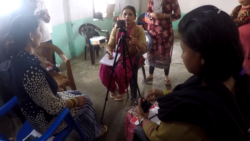Project details: CARAN
Aims
- To develop methodologies of co-production and participatory film-making in order to identify critical barriers to preventing and controlling antibiotic resistance at the individual, household and community levels, and community-led solutions to overcoming those barriers.
- To develop a health-education campaign that will target local communities with documentary films about antibiotic resistance.
- To develop an advocacy campaign that will raise awareness of the issues identified and the communities' solution to them with district and national-level policy makers.
- To pilot-test the participatory film-making, health education campaign and advocacy campaign in one urban and one rural setting.
- To evaluate the feasibility of the pilot with regard to reach, implementation fidelity and acceptability for a range of stakeholders.
- To engage with national stakeholders in order to maximise impact amongst the policy-making community across Nepal.
- To provide a scalable model for arts-and-humanities-based participatory-development that can be used by NGOs and the communities they support in a range of public-health contexts in Nepal and other LMICs.
Methods
 This project used participatory film-making as its key method to engage communities with the issue of AMR. We ran week-long training sessions where participants were introduced to the concept of AMR and explored their own relationship with this challenge. Alongside AMR education, workshops taught participants how to use film-making equipment, develop storylines, create clear messages and cut their final product. This allowed the groups to co-produce 6 short films describing local experiences of AMR in action and suggesting behavioural changes to modify AMR risks. Films were shared during community showcasing events where the local people (including government officials) were invited to attend.
This project used participatory film-making as its key method to engage communities with the issue of AMR. We ran week-long training sessions where participants were introduced to the concept of AMR and explored their own relationship with this challenge. Alongside AMR education, workshops taught participants how to use film-making equipment, develop storylines, create clear messages and cut their final product. This allowed the groups to co-produce 6 short films describing local experiences of AMR in action and suggesting behavioural changes to modify AMR risks. Films were shared during community showcasing events where the local people (including government officials) were invited to attend.
Health professionals within our team supported this methodology by designing a pre-testing phase allowing us to scope the needs of our community and to understand their use of language around AMR, antibiotics and illness more generally. This facilitated the development of a much stronger intervention which was specifically tailored to the needs of each community.

We worked in two sites within the Kathmandu valley, one urban and one peri-urban. Identification of sites was guided by our Nepali team members from HERD international. We worked with 44 individuals across both sites however our showcasing events allowed the project to reach a further 231 individuals (excluding the families of original participants).
